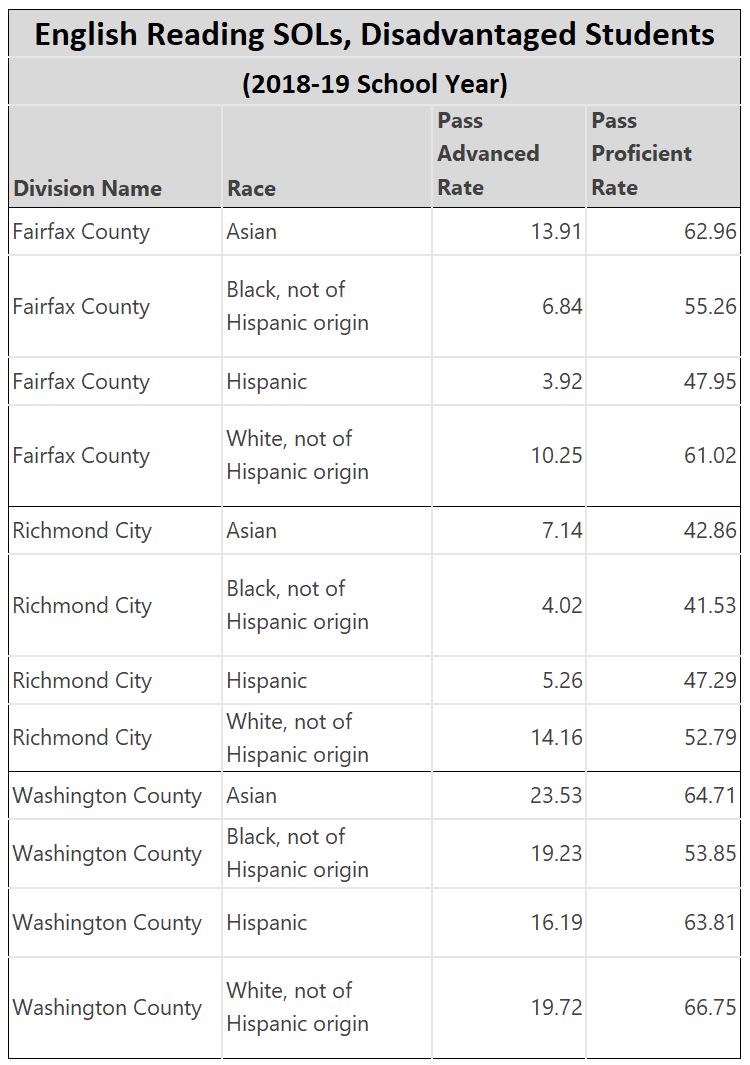A reader has forwarded to me an email exchange between herself and the Virginia Department of Education (VDOE) regarding the implementation of Critical Race Theory (CRT) in Virginia schools,
My correspondent received a polite response from “Constituent Services” thanking her for her query. Without addressing CRT directly, the VDOE representative mentioned a number of Northam administration initiatives regarding the teaching of history and implementation of culturally relevant practices. Then she wrote the following, which describes the Northam approach to K-12 education more clearly and succinctly than I have seen anywhere.
Our goal is to maximize the potential of ALL learners by eliminating the predictability of student outcomes based on race, gender, zip code, ability, socioeconomic status, or languages spoken at home. This will be accomplished through continuous reflection, cultural responsiveness, courageous leadership, compassionate student and family engagement, and curriculum reframing.
The phrase “eliminating the predictability of student outcomes” is another way of saying “achieving equal outcomes.” The Northam team believes that overhauling the teaching of history, making curricula more culturally “responsive,” and “engaging” students and families (in a manner unspecified here, but likely lecturing them about white privilege and racism), will reduce the learning gap between whites and Asians on the one hand and blacks and Hispanics on the other.
The proof will be in the pudding. When Virginia resumes Standards of Learning (SOL) testing, we will be able to see if implementing Critical Race Theory-inspired changes to school culture and curriculum helps to close the racial/ethnic achievement gap. Analysis will be made more difficult by the statistical noise created by the watering down of SOL standards and by varying policies across the state regarding COVID-related school closings. But at some point in the distant future, we will get a clearer picture.
There is another way, though not as precise as we’d like, to gauge the impact sooner. That is to compare Virginia’s most “woke” school districts with its least “woke” school districts. The City of Richmond and Fairfax County were two of the Virginia school districts where the principles of wokeness already had made tremendous inroads the last year the SOLs were administered, the 2018-2019 school year. Washington County, in the far southwest, is located in the beating red heart of Trump country, embedded in one of the least woke cultural milieus found in Virginia. Unlike many other counties in Virginia’s western marches, Washington has enough black, Asian and Hispanic students to allow for SOL comparisons.
Using data from the Virginia Department of Education Build-a-Table, I compared the percentage of disadvantaged students who passing English Reading SOLs at proficient (basic grade-level) and advanced levels. (Note: I am comparing disadvantaged students for each racial/ethnic group to eliminate the well-known influence of socioeconomic class on academic achievement.)
Every major racial/ethnic group in Washington County out-performed peer groups in Richmond and Fairfax as measured by the percentage that passed the English Reading SOL at a proficient level, and by even wider margins that passed at an advanced level.
Particularly impressive is the performance of disadvantaged black and Hispanic students in Washington County who performed at advanced levels. Nearly one in five disadvantaged black students scored “advanced” in Washington County compared to 4% in Richmond and 7% in Fairfax.
Bottom line: Despite being dominated by knuckle-dragging red state voters with all their retrograde attitudes about race (note to Southwest Virginians: I’m being facetious), Washington County did a superior job of “eliminating the predictability of student outcomes based on race, gender, zip code, ability, socioeconomic status.” Strangely, I see no evidence that the Northam administration is turning to Washington County for inspiration.
Obviously, this is a quick, superficial comparison. Perhaps Washington County schools are more woke than I give them credit for. Perhaps there are differences in the percentages of English Learner students in three localities, which would complicate comparisons of Asian and Hispanic students. Perhaps the geographic distribution of poverty within school districts is a factor.
Some readers will rightly observe that the economically disadvantaged black students in Washington County were not concentrated in pockets of poverty like they are in Richmond. But that fact supports my argument: It does not appear that being submerged in a sea of cultural whiteness harmed black and Hispanic students in any way.
It’s worth doing a more authoritative analysis than what I have done here. But this preliminary cut of the data provides no support for the proposition that making Virginia schools more woke will do anything to improve academic performance of minority students or reduce the black-white education gap. To the contrary, setting high standards and focusing on fundamentals is likely the policy best geared to helping minority students.
I will venture a prediction: Four years of inculcating wokeness in Virginia schools will do nothing to close the academic-achievement gap and may, in fact, make it worse. The more woke the school district, the more harmful the results will be.




